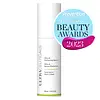What's inside
What's inside
 Key Ingredients
Key Ingredients

 Benefits
Benefits

 Concerns
Concerns

 Ingredients Side-by-side
Ingredients Side-by-side

Water
Skin ConditioningCoco-Caprylate/Caprate
EmollientDimethicone
EmollientGlycerin
HumectantPolysorbate 80
EmulsifyingHydroxyethyl Acrylate/Sodium Acryloyldimethyl Taurate Copolymer
Emulsion StabilisingBisabolol
MaskingStearyl Glycyrrhetinate
Skin ConditioningCetearyl Dimethicone Crosspolymer
Benzyl Alcohol
PerfumingJojoba Esters
EmollientButylene Glycol
HumectantBHT
AntioxidantSodium Hyaluronate
HumectantTocopheryl Acetate
AntioxidantHydroxyethylcellulose
Emulsion StabilisingPropanediol
SolventPolysorbate 20
EmulsifyingRetinol
Skin ConditioningSalicylic Acid
MaskingDisodium EDTA
Polysorbate 60
EmulsifyingSorbitan Isostearate
EmulsifyingClimbazole
AntimicrobialSodium Hydroxide
BufferingSodium Lactate
BufferingCarbomer
Emulsion StabilisingSorbic Acid
PreservativeDisodium Phosphate
BufferingPalmitoyl Tripeptide-5
Skin ConditioningXanthan Gum
EmulsifyingSodium Phosphate
BufferingSaccharide Isomerate
HumectantGlyceryl Caprylate
EmollientBHA
AntioxidantTocopherol
AntioxidantPalmitoyl Tripeptide-1
Skin ConditioningPalmitoyl Tetrapeptide-7
Skin ConditioningWater, Coco-Caprylate/Caprate, Dimethicone, Glycerin, Polysorbate 80, Hydroxyethyl Acrylate/Sodium Acryloyldimethyl Taurate Copolymer, Bisabolol, Stearyl Glycyrrhetinate, Cetearyl Dimethicone Crosspolymer, Benzyl Alcohol, Jojoba Esters, Butylene Glycol, BHT, Sodium Hyaluronate, Tocopheryl Acetate, Hydroxyethylcellulose, Propanediol, Polysorbate 20, Retinol, Salicylic Acid, Disodium EDTA, Polysorbate 60, Sorbitan Isostearate, Climbazole, Sodium Hydroxide, Sodium Lactate, Carbomer, Sorbic Acid, Disodium Phosphate, Palmitoyl Tripeptide-5, Xanthan Gum, Sodium Phosphate, Saccharide Isomerate, Glyceryl Caprylate, BHA, Tocopherol, Palmitoyl Tripeptide-1, Palmitoyl Tetrapeptide-7
Water
Skin ConditioningSodium Cocoyl Glycinate
CleansingGlycerin
HumectantSodium Methyl Cocoyl Taurate
CleansingCocamidopropyl Betaine
CleansingSodium Chloride
MaskingGlycol Stearate
EmollientAcrylates Copolymer
Sodium Lactate
BufferingMelissa Officinalis Leaf Extract
Skin ConditioningNiacinamide
SmoothingPanthenol
Skin ConditioningCucumis Sativus Fruit Extract
EmollientCocos Nucifera Oil
MaskingCaprylyl Glycol
EmollientCaprylhydroxamic Acid
Lauric Acid
CleansingDisodium EDTA
Sodium Benzoate
MaskingPotassium Sorbate
PreservativeLavandula Angustifolia Oil
MaskingPelargonium Graveolens Oil
MaskingSodium Hydroxide
BufferingCitric Acid
BufferingLinalool
PerfumingWater, Sodium Cocoyl Glycinate, Glycerin, Sodium Methyl Cocoyl Taurate, Cocamidopropyl Betaine, Sodium Chloride, Glycol Stearate, Acrylates Copolymer, Sodium Lactate, Melissa Officinalis Leaf Extract, Niacinamide, Panthenol, Cucumis Sativus Fruit Extract, Cocos Nucifera Oil, Caprylyl Glycol, Caprylhydroxamic Acid, Lauric Acid, Disodium EDTA, Sodium Benzoate, Potassium Sorbate, Lavandula Angustifolia Oil, Pelargonium Graveolens Oil, Sodium Hydroxide, Citric Acid, Linalool
Ingredients Explained
These ingredients are found in both products.
Ingredients higher up in an ingredient list are typically present in a larger amount.
Disodium EDTA plays a role in making products more stable by aiding other preservatives.
It is a chelating agent, meaning it neutralizes metal ions that may be found in a product.
Disodium EDTA is a salt of edetic acid and is found to be safe in cosmetic ingredients.
Learn more about Disodium EDTAGlycerin is already naturally found in your skin. It helps moisturize and protect your skin.
A study from 2016 found glycerin to be more effective as a humectant than AHAs and hyaluronic acid.
As a humectant, it helps the skin stay hydrated by pulling moisture to your skin. The low molecular weight of glycerin allows it to pull moisture into the deeper layers of your skin.
Hydrated skin improves your skin barrier; Your skin barrier helps protect against irritants and bacteria.
Glycerin has also been found to have antimicrobial and antiviral properties. Due to these properties, glycerin is often used in wound and burn treatments.
In cosmetics, glycerin is usually derived from plants such as soybean or palm. However, it can also be sourced from animals, such as tallow or animal fat.
This ingredient is organic, colorless, odorless, and non-toxic.
Glycerin is the name for this ingredient in American English. British English uses Glycerol/Glycerine.
Learn more about GlycerinSodium Hydroxide is also known as lye or caustic soda. It is used to adjust the pH of products; many ingredients require a specific pH to be effective.
In small amounts, sodium hydroxide is considered safe to use. However, large amounts may cause chemical burns due to its high alkaline.
Your skin has a natural pH and acid mantle. This acid mantle helps prevent harmful bacteria from breaking through. The acid mantle also helps keep your skin hydrated.
"Alkaline" refers to a high pH level. A low pH level would be considered acidic.
Learn more about Sodium HydroxideSodium Lactate is the sodium salt of lactic acid, an AHA. It is a humectant and sometimes used to adjust the pH of a product.
This ingredient is part of our skin's NMF, or natural moisturizing factor. Our NMF is essential for the hydration of our top skin layers and plasticity of skin. NMF also influences our skin's natural acid mantle and pH, which protects our skin from harmful bacteria.
High percentages of Sodium Lactate can have an exfoliating effect.
Fun fact: Sodium Lactate is produced from fermented sugar.
Learn more about Sodium LactateWater. It's the most common cosmetic ingredient of all. You'll usually see it at the top of ingredient lists, meaning that it makes up the largest part of the product.
So why is it so popular? Water most often acts as a solvent - this means that it helps dissolve other ingredients into the formulation.
You'll also recognize water as that liquid we all need to stay alive. If you see this, drink a glass of water. Stay hydrated!
Learn more about Water